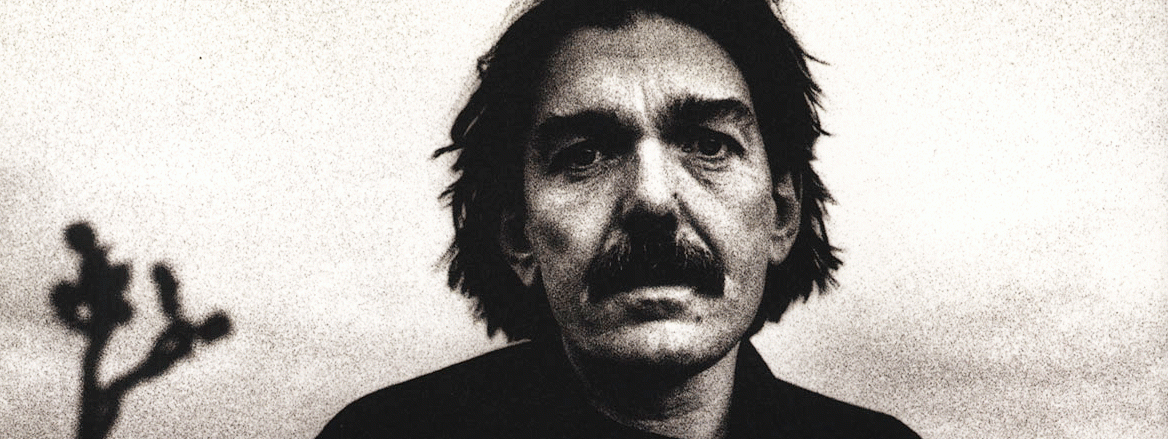Today Captain Beefheart aims to make the canvas sing
Captain Beefheart, iconoclastic musical inventor of the ’60s and ’70s, is alive and well – in a sense. He’s going by his real name these days, Don Van Vliet, and he’s not making music anymore. He’s painting.
Although the last LP by Captain Beefheart and the Magic Band was “Ice Cream for Crow” in 1982, Van Vliet insists that “I am making music-on canvas.” Beefheart’s reputation as one of the most original figures in modern “popular” music culminated in his classic 1969 album, “Trout Mask Replica,” which was voted No. 33 on the top 100 most important LPs by Rolling Stone magazine. For the last 20 years, Van Vliet has aimed at returning full time to practicing his life’s first creative inclination.
Now he spends his time in his home studio somewhere on the rugged coast of northern California (the location he keeps secret), where he has lived since 1982 with his wife of many years, Jan, and a beloved cat, Garland-inhaling Pacific Ocean air spiked with the smoke of good cigars and, in creative spells that sometimes keep him awake days on end, putting dramatic and fantastic oil-paint images on enormous canvases.
Van Vliet’s works are admired by such artists as Julian Schnabel and A.R. Penck and have been exhibited the prestigious Mary Boone Gallery in New York; the Galerie Michael Werner in Cologne, Germany; and the Waddington Galleries in London.
Don Van Vliet, artist, has been discovered at age 47. “Yeah, I’m 47 years out,” he said, laughing, after being reached by phone for one of the rare interviews he has granted in recent years. “But I string the four and shoot the seven so fast that it becomes a one – that’s how old I am!”
Talking to the artist, it should be noted, is like reading haiku or dense Chinese prose. His language is abbreviated, heavily metaphoric, symbolic and allusory. There is no directing him, no putting him through standard interview questions and answers. It’s too boring. He bolts, goes his own way. Ask a simple question, you get a poetic response; ask a poetic question, you get a simple response.
Apropos of nothing, Van Vliet is apt to describe the chaotic web of the black widow spider as “brilliant,” or to come up with an epigram like ” Business is yogurt with wrenches,” or to find esthetic merit in Bela Lugosi’s widow’s peak or movie cowboy Gabby Hayes’ beard.
Here is about as literal an explanation as you will ever get from Van Vliet of just exactly what he does in his paintings: “Actually, what I try to do is turn myself inside out on canvas, to freeze the moment so that the person seeing it can observe what I froze. I try to turn what is going on in me into a still life of that moment.”
At that moment, Van Vliet was speaking from his studio, which he said was full of enormous canvases, new and old, and marked by paint-splotches and spatters on the walls. Outside, a mere 100 yards away, the ocean roared gray and “freight-trainlike.” The air, he said, smelled like a “a Robustos Cohiba,” mostly because that was the cigar he was smoking-and also “like pine trees dipped in sun batter.”
“What am I reading?” he said. “That guy, I can never think of his name-Dick Francis (a British mystery writer). He’s good. You know who reads him? Phillip Larkin (a postwar British poet). God, I’d love to have met him. Great poet. The best, really, I think.
“What is my favorite poem by Larkin? The one about the moon: ‘And looking out to see the moon thinned/To an air-sharpened blade.’ God, that’s good.’ ”
John R. Lane, director of the San Francisco Museum of Modern Art, calls Van Vliet, who is mostly self-educated, a “modernist primitive.”
His paintings often contain images of wolves, bats, demons, skeletons, cats and themes from nature, which Van Vliet has long felt close to; he even lived for a time in the Southern California desert. As Lane wrote in a program introducing a recent exhibition, the paintings are “intended to effect psychological, spiritual and magical force.”
The artist often speaks fondly of his painting “Band and Cat Panda,” perhaps because in its creation he had a collaborator, of sorts. One morning as he worked, his cat, Garland, proceeded to sharpen his claws on the lower right corner of the work that became “Band and Cat Panda.”
“Garland just fooled around,” Van Vliet says. “I won. I bought the canvas! He just enjoyed scratching it, cleaning his little toenails, his little protein points.”
Van Vliet intersperses his talk with excerpts from some of his favorite music as he plays them over the phone: a tape of blues musician Eddie “One-String Sam” Jones demonstrating how he gets so many tones from one string; a recording of “You Ain’t Too Old” by Slim Green and the Cats from Fresno; “Take the A-Train,” a favorite recording with Duke Ellington and vocalist Betty Roche; “Bedbug Blues” by Lightning Slim; and occasionally excerpts from his own “Trout Mask Replica.”
– Rip Rense, 1989
